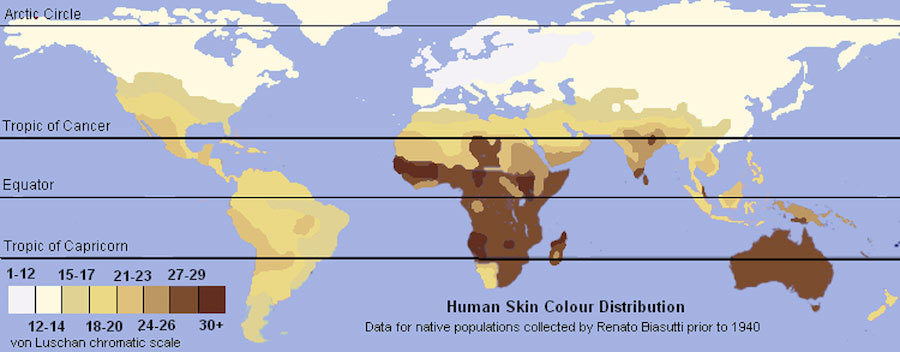
Would it be genetically possible for two individuals to populate the Earth?
April 7, 2005

- Related Topics:
- Quirky questions,
- Dominant and recessive,
- Carrier,
- Human evolution
A curious adult from Florida asks:
“Would it be genetically possible for two individuals to populate the Earth? What complications could arise?”
Another fun question! It certainly would be possible. The complications would depend on who the two people were, and how long ago the couple started out.
What everyone would be worried about, I think, are genetic diseases. Hemophilia was pretty common in European royalty. Around 1 in 20 Pingalese Islanders are severely colorblind (instead of the 1 in 20,000 everywhere else).1
Polydactyly, or extra fingers and toes are more common among the Amish of Pennsylvania due to a specific genetic condition.2 Ashkenazi Jews have a higher rate of Tay Sachs and cystic fibrosis (CF).3
What do all of these groups have in common? Each started from a small group and there was limited contact with the outside world.
The result is a higher rate of certain genetic diseases. Why is this?
Recessive genes and the founder effect
Because each of us carries the seeds for at least 5 or 10 genetic diseases within our DNA. Most of us don’t have these diseases because we only have one copy of these recessive genes.
What recessive means is that you need to have two copies of the disease version of the gene to get the disease. If you have a normal copy and a disease copy, you end up not having the disease. But you are a carrier.
And if two carriers have kids, then there is a 25% chance that the kids will have the disease. In a small, interrelated group, up to half of the people may be carriers. This obviously greatly increases the chances that carriers will meet and have kids.
This is called the founder effect. When a population is founded by just a small number of individuals, the genetic diseases they carry will become much more common in the population. This is what happened to the groups mentioned above, like the Pingalese islanders and the Amish.

The flip side of this is that some diseases essentially disappear from the population. This is why it would depend on who the founders were. If they were disease gene free (which none of us living today are), then the complications would be minor. But if they harbored any recessive mutations, which most humans do, then genetic diseases might become a problem.
New mutations over time
All of these examples have not been going on for very long, on the order of a few hundred years or so. What would happen over thousands or even hundreds of thousands of years?
Well, it would all work out over hundreds of thousands of years certainly. Groups would split up, become separated, and form new groups. Each one of these would then have their own genetic baggage.
For example, if current theories are to be believed, our ancestors left Africa in waves over the past 100,000 years or so. Each of these groups was probably small and grew in isolation from the rest of humanity.
The result? What you see around you. Northern Europeans have a higher incidence of CF. Africans have a higher incidence of sickle cell anemia. Southeast Asians have a higher incidence of alpha-thalassemia.

If our original two people didn’t have these diseases, then where would the disease genes come from? Well, new mutations happen all the time. Most are harmless, a few are harmful, and a very few are beneficial.
With lots of people over a long period of time, some bad mutations are bound to develop. For example, we see them happening today in a disease called neurofibromatosis (NF). About half of all new cases of NF are because of new mutations.4
Evolution of human traits
What we’ve discussed for genetic diseases is also true for other things like genetic traits. Our ancestors in Africa were most likely dark-skinned with brown eyes. A group that reached Northern Europe developed mutations that gave blue eyes, red and blonde hair, and light skin.
These same mutations could have developed in Africa. In fact, they probably did but disappeared because people with fair skin may not have done as well there.
In Northern Europe, these mutations were actually beneficial (probably to get enough vitamin D from the sun). This meant that once the mutation popped up, these people did better and so eventually, most Northern Europeans ended up with light skin.
I could go on and on about this. Instead, let’s get back to your original question.
It certainly seems possible that two people could populate the Earth with minimal complications. That is, as long as they weren’t harboring too many devastating genetic disease genes and/or enough time passed.

Author: Dr. Barry Starr
Barry served as The Tech Geneticist from 2002-2018. He founded Ask-a-Geneticist, answered thousands of questions submitted by people from all around the world, and oversaw and edited all articles published during his tenure. AAG is part of the Stanford at The Tech program, which brings Stanford scientists to The Tech to answer questions for this site, as well as to run science activities with visitors at The Tech Interactive in downtown San Jose.
 Skip Navigation
Skip Navigation
